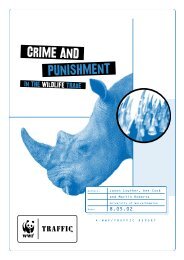Forest renaissance - The role of state forestry in Britain ... - WWF UK
Forest renaissance - The role of state forestry in Britain ... - WWF UK
Forest renaissance - The role of state forestry in Britain ... - WWF UK
Create successful ePaper yourself
Turn your PDF publications into a flip-book with our unique Google optimized e-Paper software.
“FE is now probably thes<strong>in</strong>gle largest provider<strong>of</strong> outdoor recreation<strong>in</strong> Brita<strong>in</strong>...”12“Monitor<strong>in</strong>g and adaptivemanagement areevolv<strong>in</strong>g but need to befurther strengthened...”towards traditional <strong>forestry</strong>. Empower<strong>in</strong>gregional staff has <strong>in</strong>creased responsivenessto local needs, eg through stakeholderpanels that <strong>in</strong>form decision-mak<strong>in</strong>g.Increased efficiency moved FE <strong>in</strong>to pr<strong>of</strong>itafter three years, but collaps<strong>in</strong>g timberprices forced it <strong>in</strong>to loss <strong>in</strong> 1999. Lossescont<strong>in</strong>ue, putt<strong>in</strong>g pressure on non <strong>in</strong>comegenerat<strong>in</strong>gactivities. <strong>Forest</strong> Enterprise hasaddressed this by lever<strong>in</strong>g additionalresources, allow<strong>in</strong>g £20 million extra<strong>in</strong>vestment over 10 years.• Plann<strong>in</strong>g has been strengthened and nowneeds to move to a landscape level: newplann<strong>in</strong>g procedures supported by GIS helpto <strong>in</strong>tegrate management, resource valuesand development, although this processnow needs to extend to the widerlandscape. <strong>Forest</strong> District Strategic Plansand <strong>Forest</strong> Design Plans are available forareas scheduled for harvest<strong>in</strong>g andplant<strong>in</strong>g; and Site Management Plans forprotected sites and features. Monitor<strong>in</strong>gand adaptive management are evolv<strong>in</strong>g butneed to be further strengthened,particularly for non-market activities.• Management is focus<strong>in</strong>g on newapproaches: alternatives to clear fell<strong>in</strong>g arebe<strong>in</strong>g piloted, although large-scale clearfell<strong>in</strong>g cont<strong>in</strong>ues. Guidance on alternativesto pesticides helps managers to m<strong>in</strong>imiseimpacts. Best practice guidel<strong>in</strong>es and use <strong>of</strong>different species are improv<strong>in</strong>g freshwatersand mitigat<strong>in</strong>g impacts on water yield.Research <strong>in</strong>to alternatives to road transportand cooperation with private <strong>forestry</strong> arereduc<strong>in</strong>g timber traffic nuisance.• External impacts have been partiallyaddressed: impacts <strong>of</strong> high deerpopulations are be<strong>in</strong>g tackled through<strong>in</strong>tegrated management. FE has beenslower at respond<strong>in</strong>g to climate change,with more work needed on plann<strong>in</strong>g,species selection and management.• Biodiversity has been more effectivelyprotected and restored: all statutorilyprotected areas on FE land havemanagement plans agreed by natureconservation agencies. Plans are be<strong>in</strong>gimplemented for all priority woodlandhabitats and framework plans for prioritynon-woodland habitats. All plantations onancient woodland sites have been surveyedand work programmes are be<strong>in</strong>g developed.New guidance on dead wood is help<strong>in</strong>gconserve biodiversity. Weaknesses <strong>in</strong>cater<strong>in</strong>g for natural reserves <strong>in</strong> <strong>Forest</strong>Design Plans have been addressed. Furtheraction is needed to br<strong>in</strong>g protected areasto favourable conservation status. Forwardplann<strong>in</strong>g for native woodland restorationshould be improved. Local plans are neededfor priority non-woodland habitats. Moreeffective l<strong>in</strong>ks are also needed to nationalhabitat and species action plans and localbiodiversity action plans, along with closercollaboration <strong>in</strong> develop<strong>in</strong>g forest habitatnetworks.• Landscape plann<strong>in</strong>g has become moresophisticated: <strong>Forest</strong> Enterprise hasimproved landscape plann<strong>in</strong>g, withcomputer-aided 3-D visualisation <strong>of</strong>different management patterns. Former<strong>in</strong>dustrial areas have been improvedthrough partnerships lead<strong>in</strong>g to newownership and management structures.A plann<strong>in</strong>g framework for ancientmonuments, agreed with the nationalheritage agencies, should improveprotection. Local authority archaeologistsand archaeological trusts <strong>in</strong>put to <strong>Forest</strong>Design Plans.• Recreational opportunities have beenexpanded and access improved: <strong>Forest</strong>Enterprise <strong>of</strong>fers 703 forest walks, 392cycle trails, nearly 800 car parks, morethan 500 picnic sites, 82 orienteer<strong>in</strong>gcourses, 41 children’s play areas, 31 visitorcentres and 27 wildlife hides. FE hosts


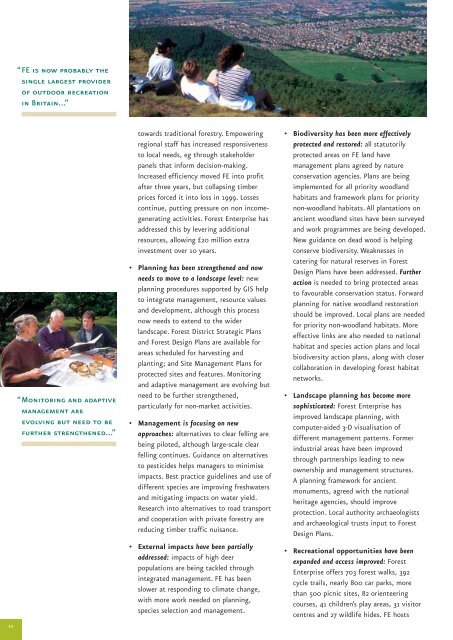
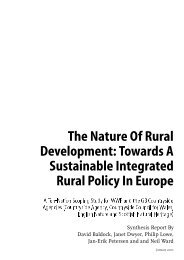
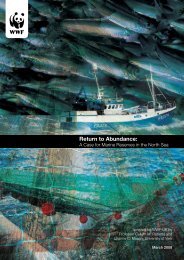

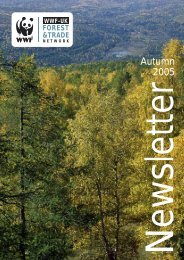

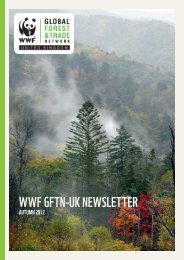


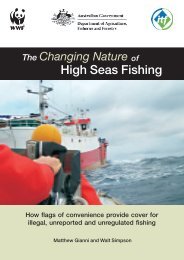
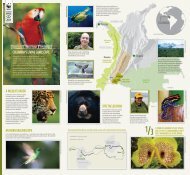
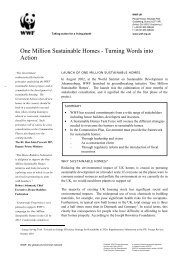
![[PDF] Causes for concern: chemicals and wildlife - WWF UK](https://img.yumpu.com/31929970/1/184x260/pdf-causes-for-concern-chemicals-and-wildlife-wwf-uk.jpg?quality=85)
